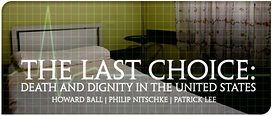The Moral Issue
My bottom line is very different from Patrick Lee’s. If a terminally ill patient, one for whom death from the illness is generally six months away, and who is competent, wishes to end his life with the assistance of a doctor, he has the liberty to do so.
I am not willing to instate communitarian values about the intrinsic value of life and block him from choosing to end his life. If, in his terminal days, he decides that his life is no longer valuable, then he can act. Who am I to tell him that his life is no longer valuable? Based on the accumulation of his life experiences, the dying person can make such a decision. Lee’s hypotheticals—a jilted teenager, or an elderly patient who wants to die so he can give organ transplants to six people, or killing a homeless person for her organs—are simply inapposite.
We are talking about a person who is dying and who refuses to live a life less than that he has experienced up until the final diagnosis. It is arrogant for Lee to tell such a person that his life remains inviolable and to stick it out to the bitter end. It is pure chutzpah to write off an individual’s choice/decision that his remaining life is not what it was and the remaining months he has to live will be increasingly painful experiences. If the dying person, possibly in great pain, and certainly not enjoying life, believes that life is no longer meaningful, then who is Lee to argue for intercession because the dying person does not agree with him?
The Legal Issue
Again and again Lee condemns the Oregon and Washington Death with Dignity Acts by either (1) saying that they will lead to involuntary euthanasia or (2) by quoting experts who tie PAD and euthanasia together in one proposed act. He says, again and again, that the vulnerable elderly and the disabled will be snared by the state and euthanized against their will. But this is the old bogeyman, the ever-dangerous “slippery slope.” No advocate for Death with Dignity supports voluntary euthanasia.
Every human endeavor, if we are not vigilant, can lead to distorted consequences. Such zealous euthanasia proponents as Derek Humphry and Dr. Jack Kevorkian were and are anathema for PAD advocates. The laws passed absolutely prohibit such action. We can prevent the slippery slope by incorporating into the law stiff barriers and by ensuring that the implementing bureaucracy does not slide down. Implementing PAD in Oregon and Washington has not led to euthanasia—voluntary or involuntary—nor will it do so if the public, the health community, and the bureaucrats administering the law act in accordance with the law’s parameters.
In another place, Lee worries that the equal protection clause will be interpreted by judges to allow non-voluntary euthanasia if PAD is decriminalized. However, Lee ignores the unanimous opinion of the U.S. Supreme Court in the 1997 New York case Vacco v Quill. In that case, lawyers for PAD advocates argued that there was no difference between PAD and a competent patient who refuses further medical treatment and dies. The Equal Protection argument was used by them to urge the justices to invalidate New York’s prohibition against PAD. The Court rejected the argument, clearly arguing that there is a fundamental difference between PAD and refusal to continue treatment. That is the law of the land and I doubt whether the decriminalization of PAD will lead to an overturn of Vacco.
Finally, I take offense at Lee’s return to his moralism in his legal arguments. He writes that PAD “does not involve the realization of a basic human good.” If I am dying and there is no meaning to my life, then PAD is my way of respecting my life and, for me, is good.

